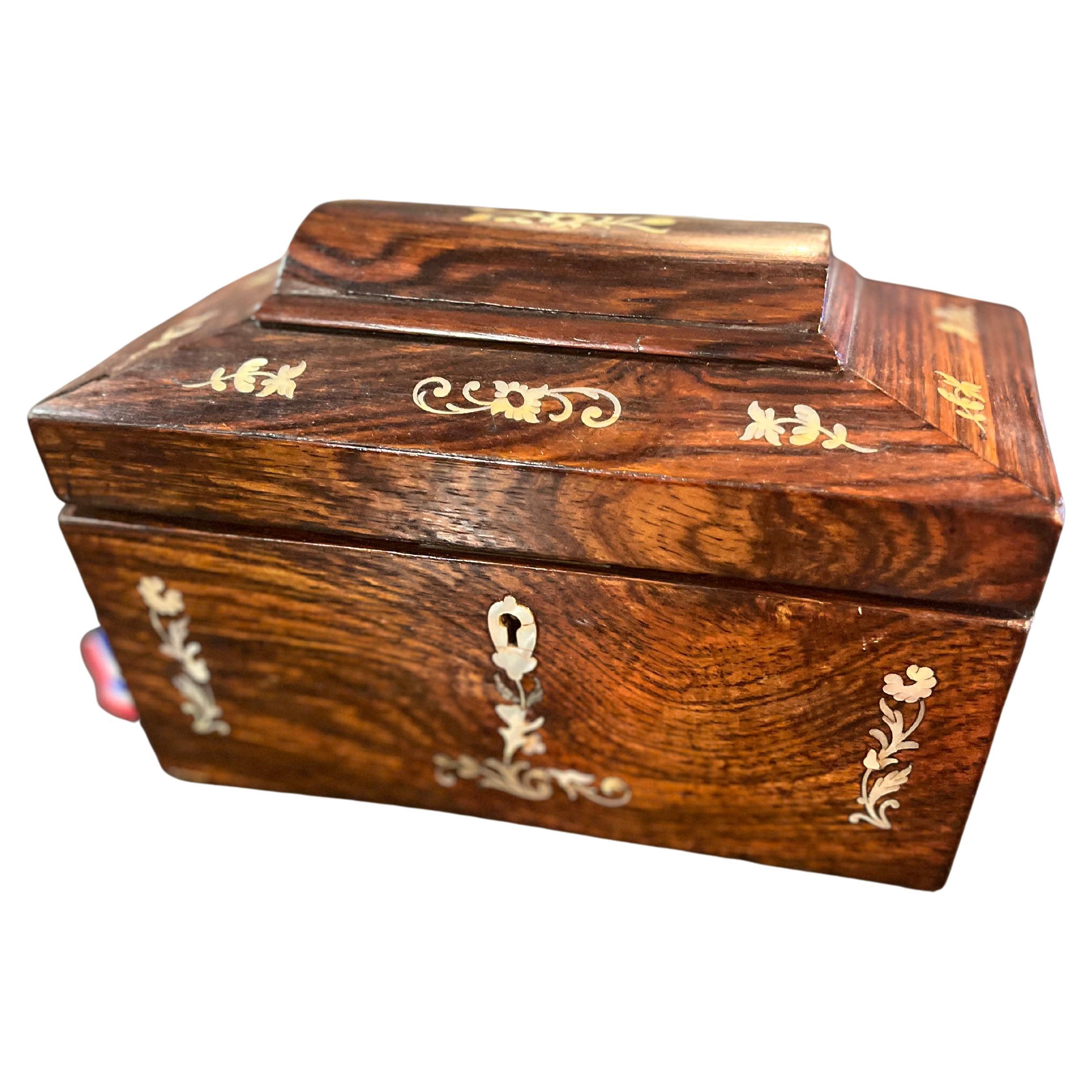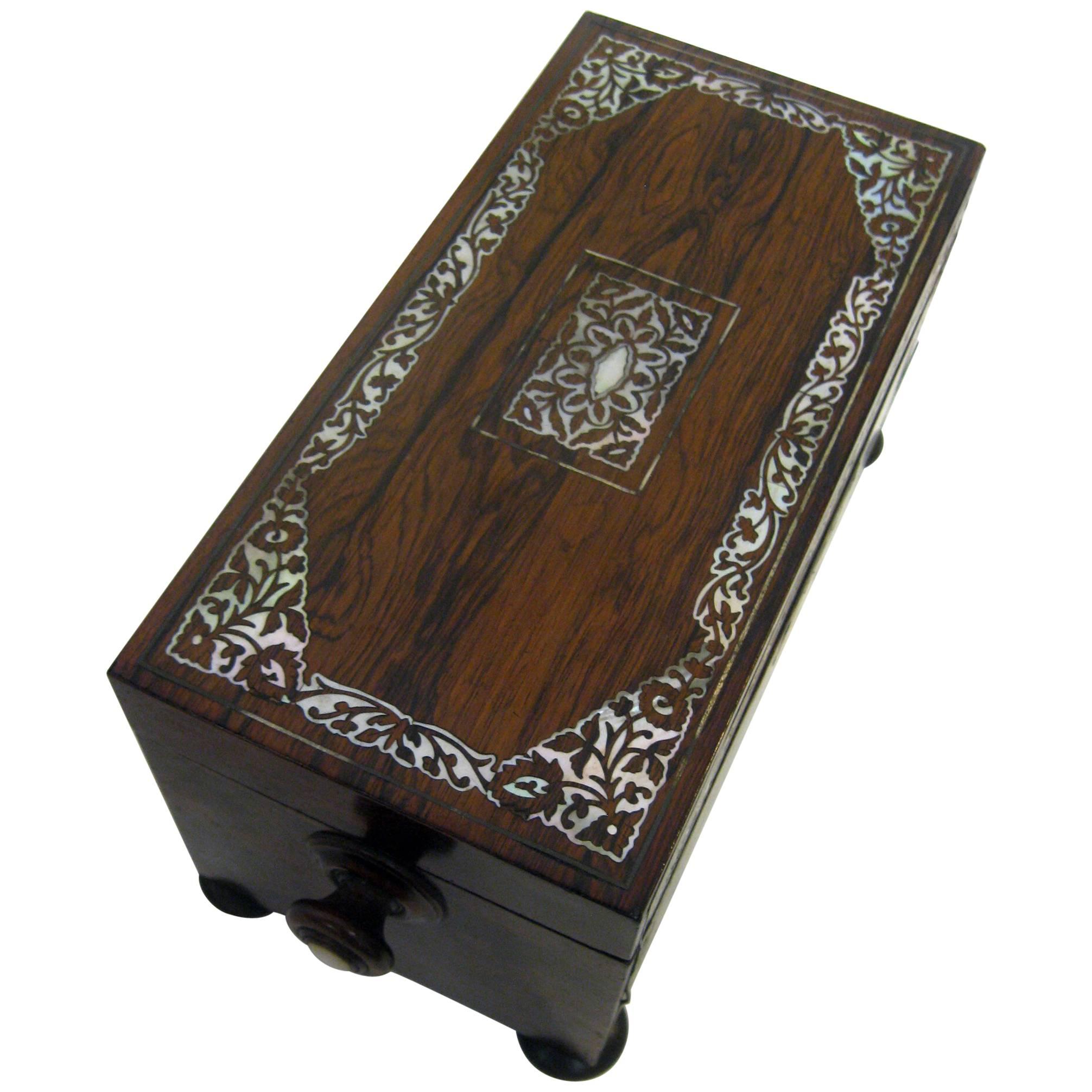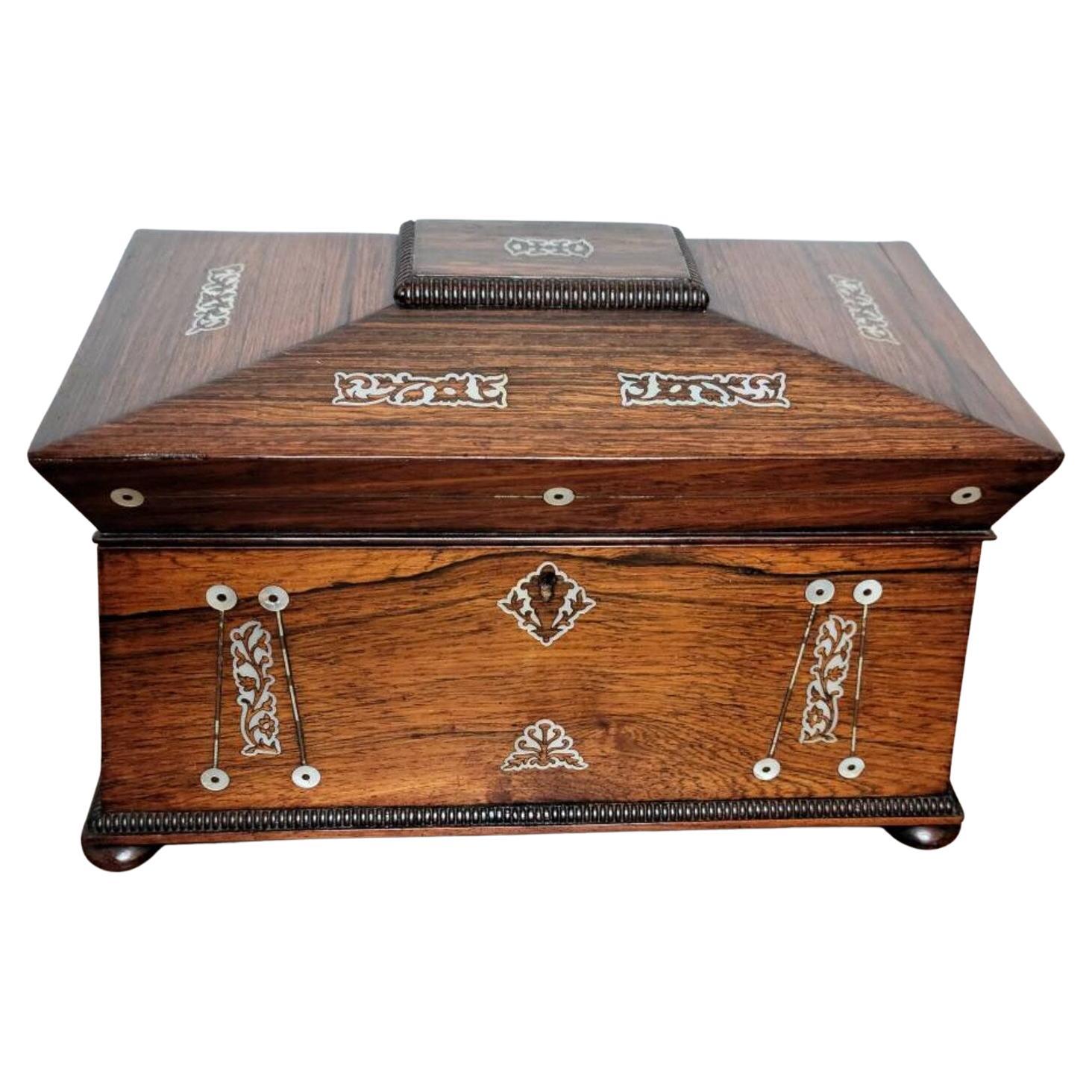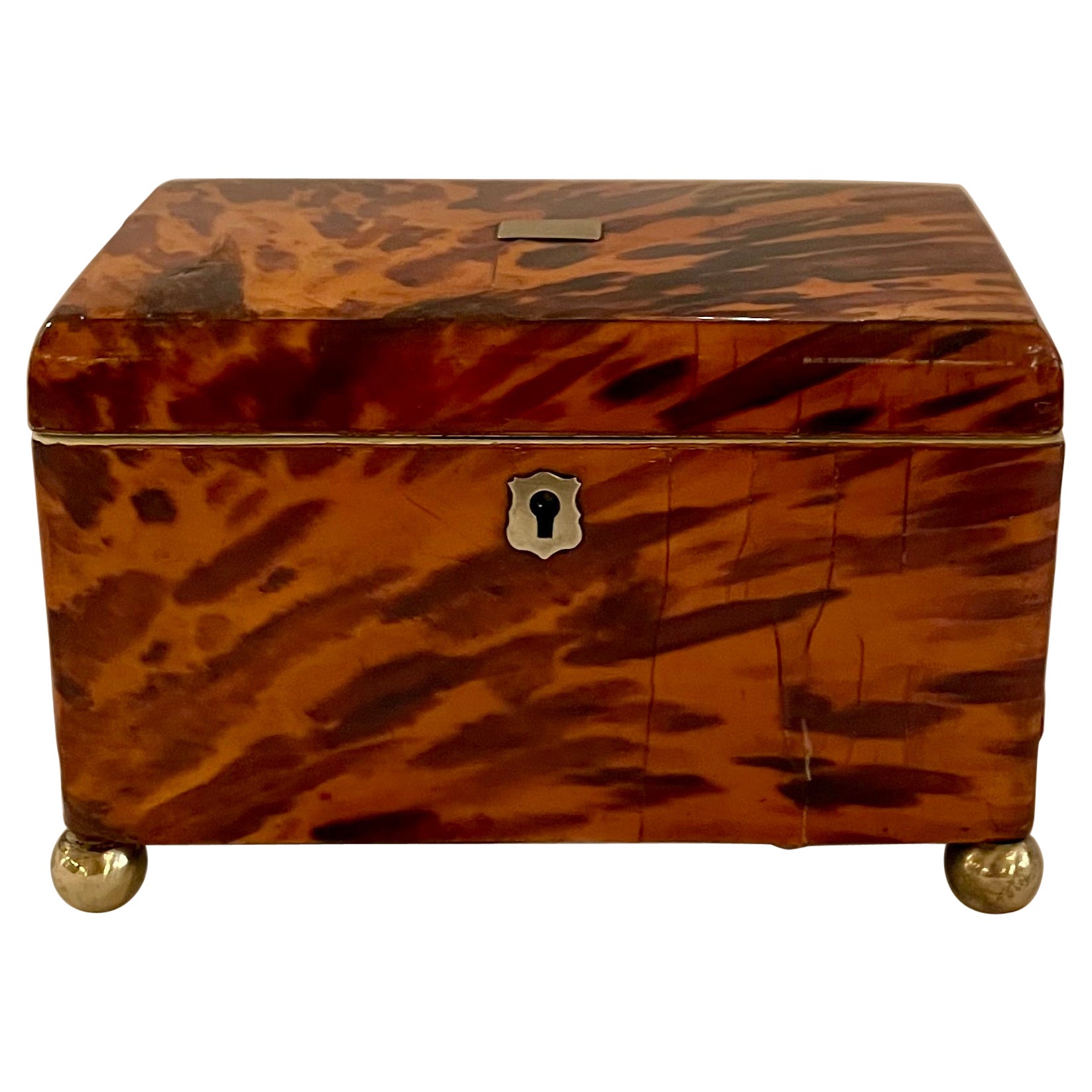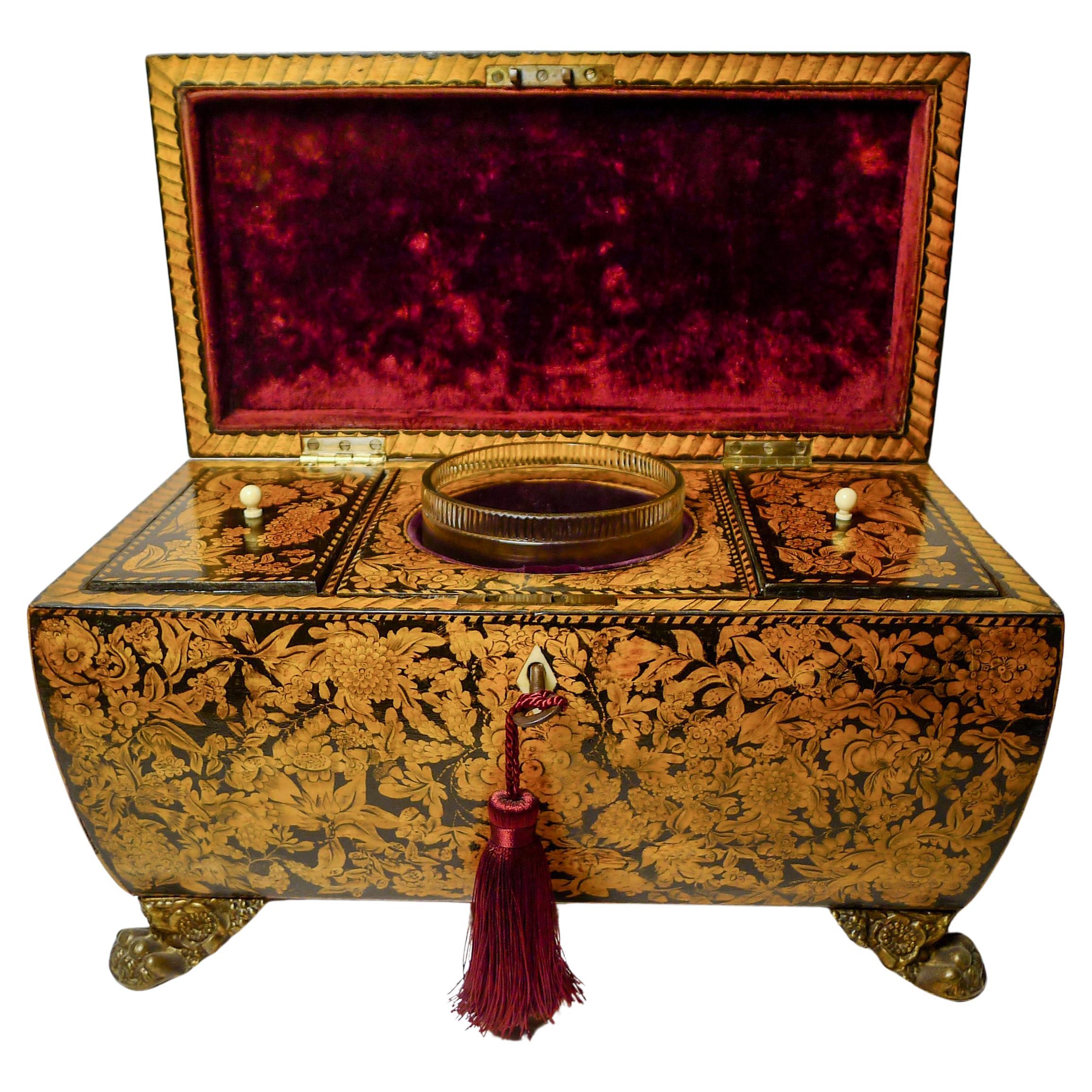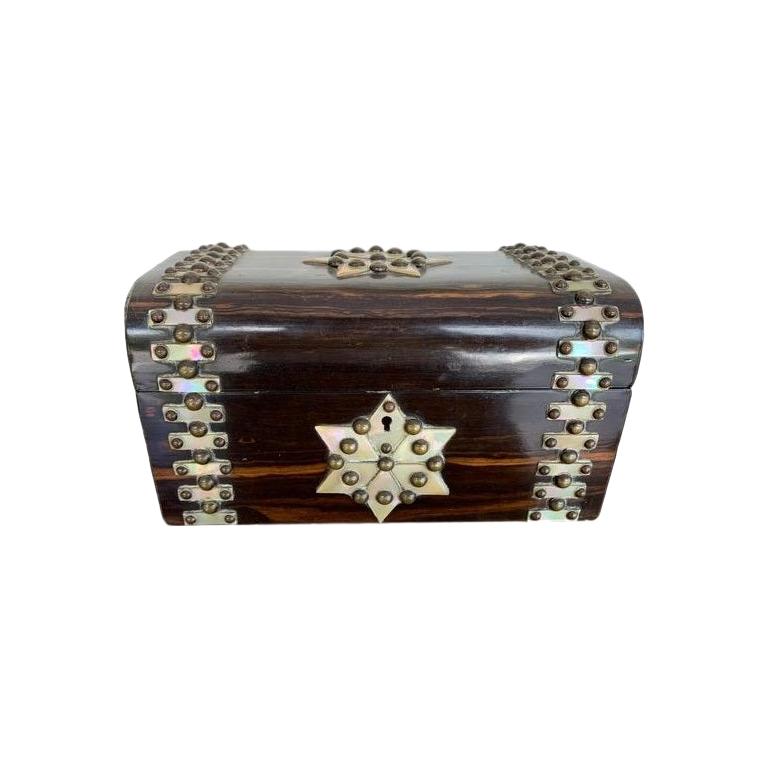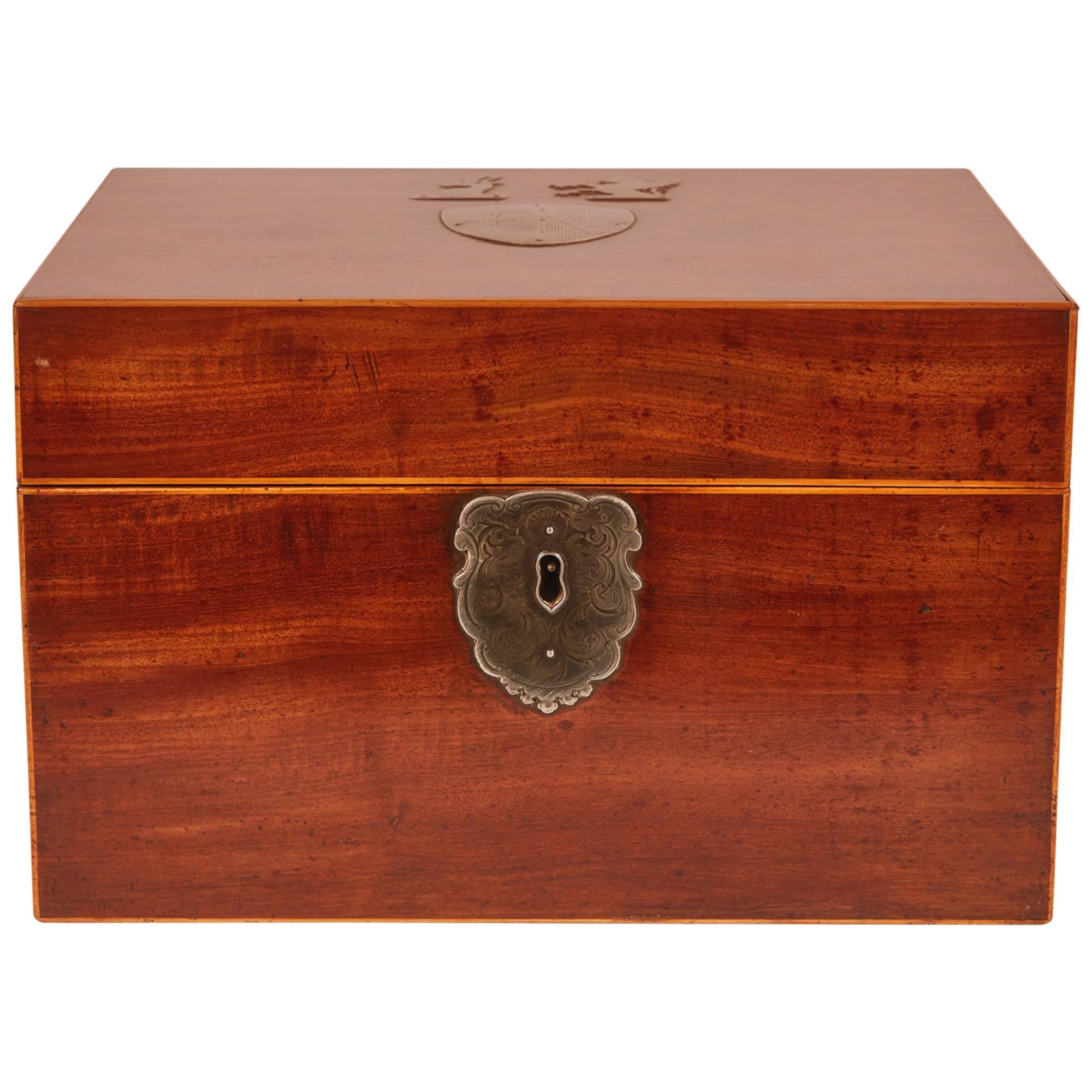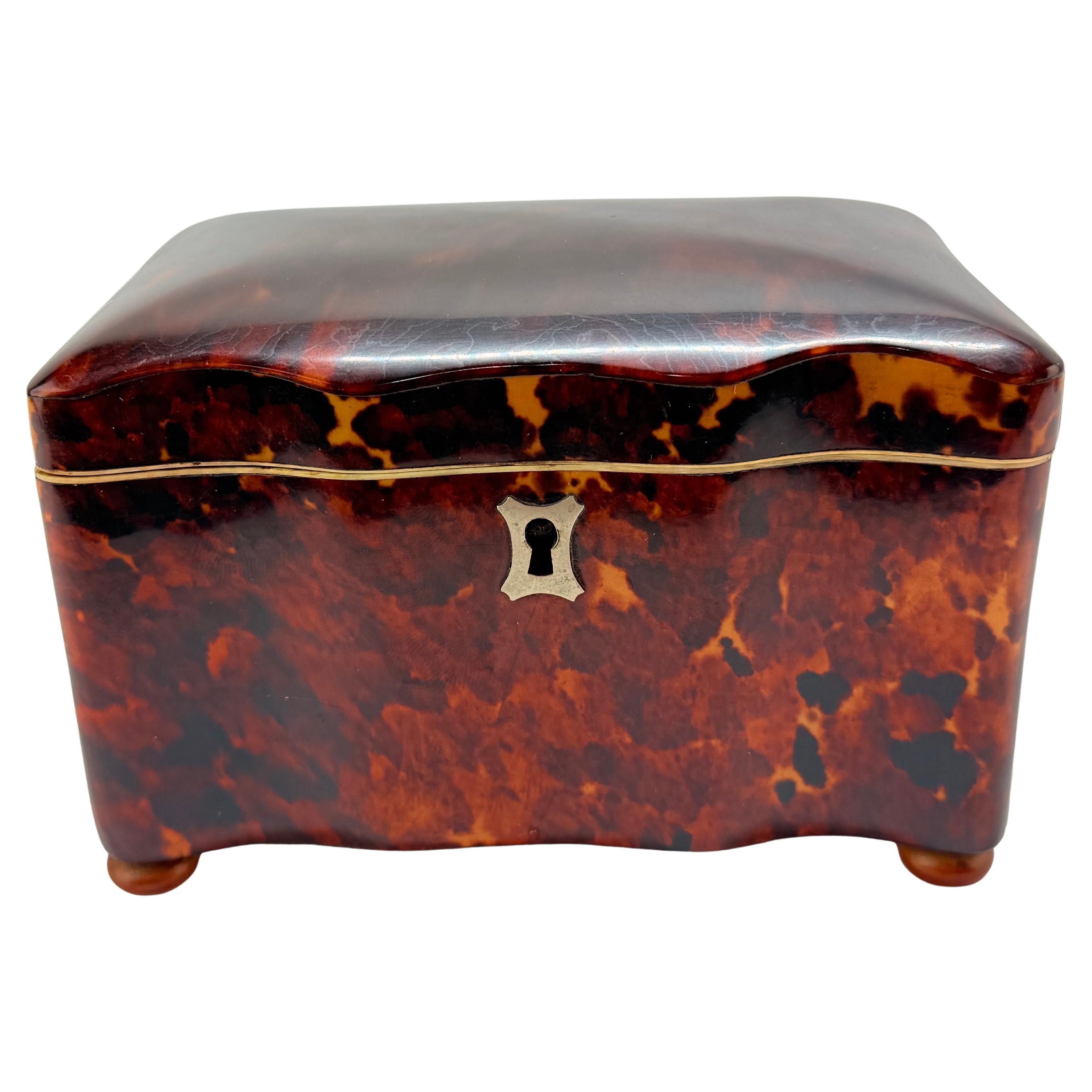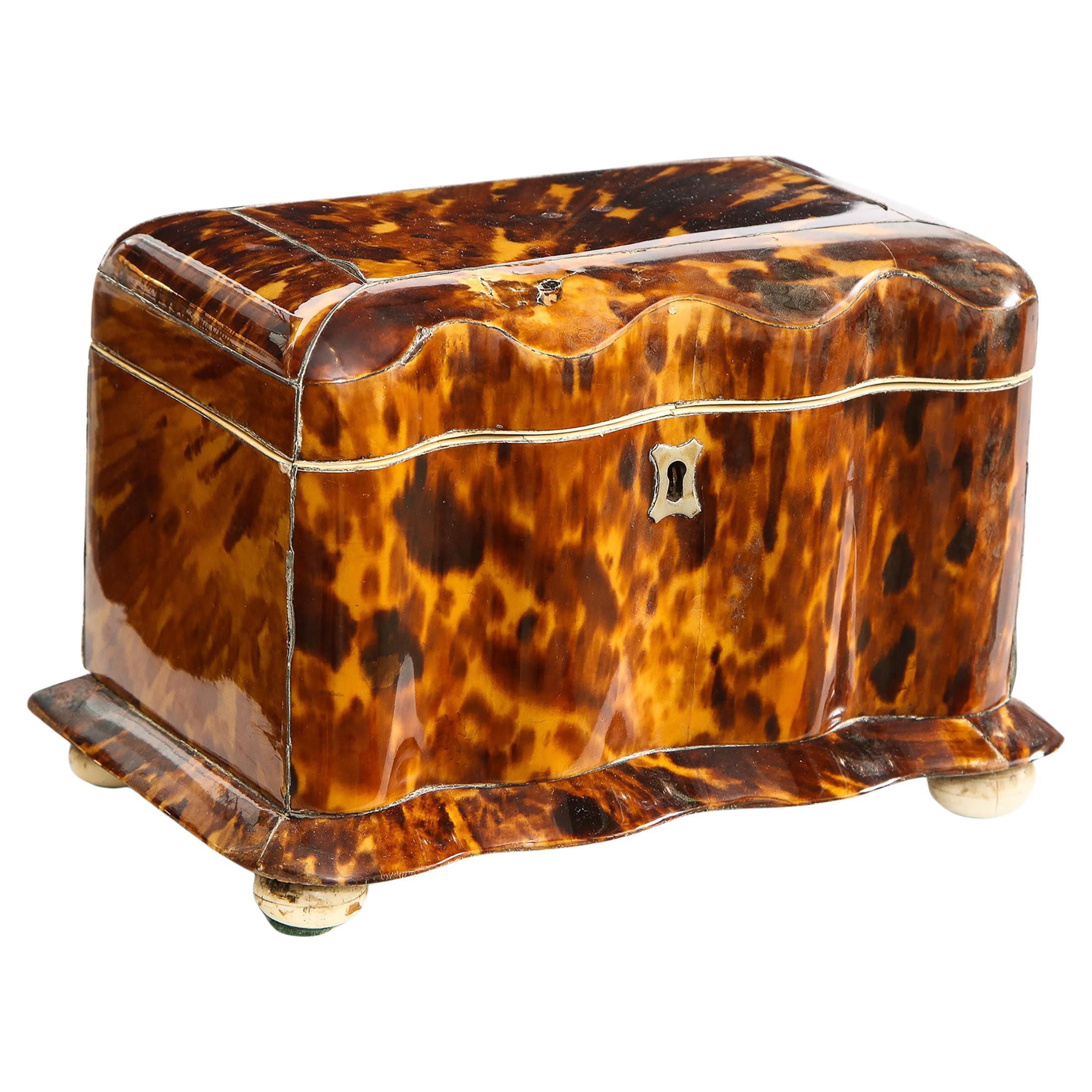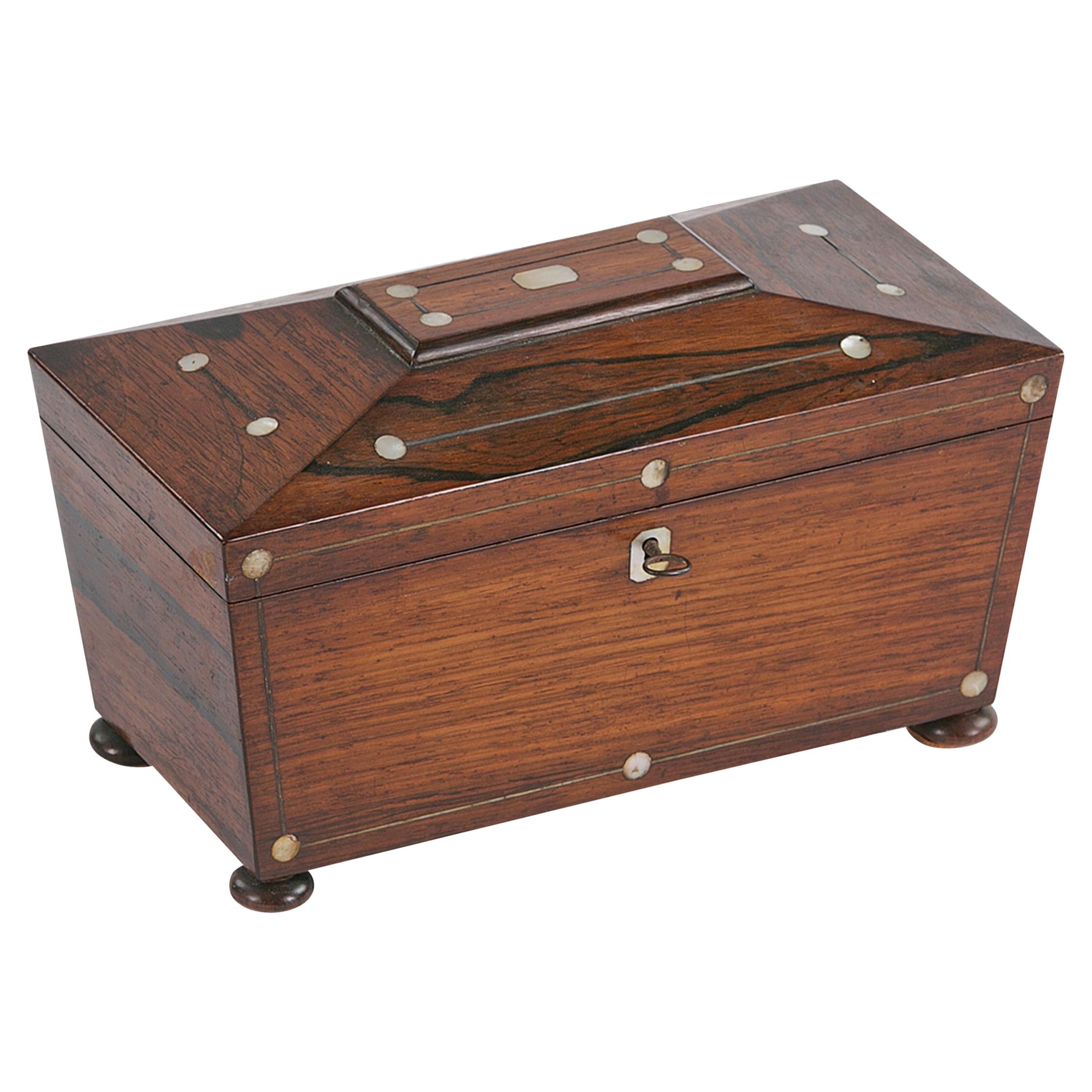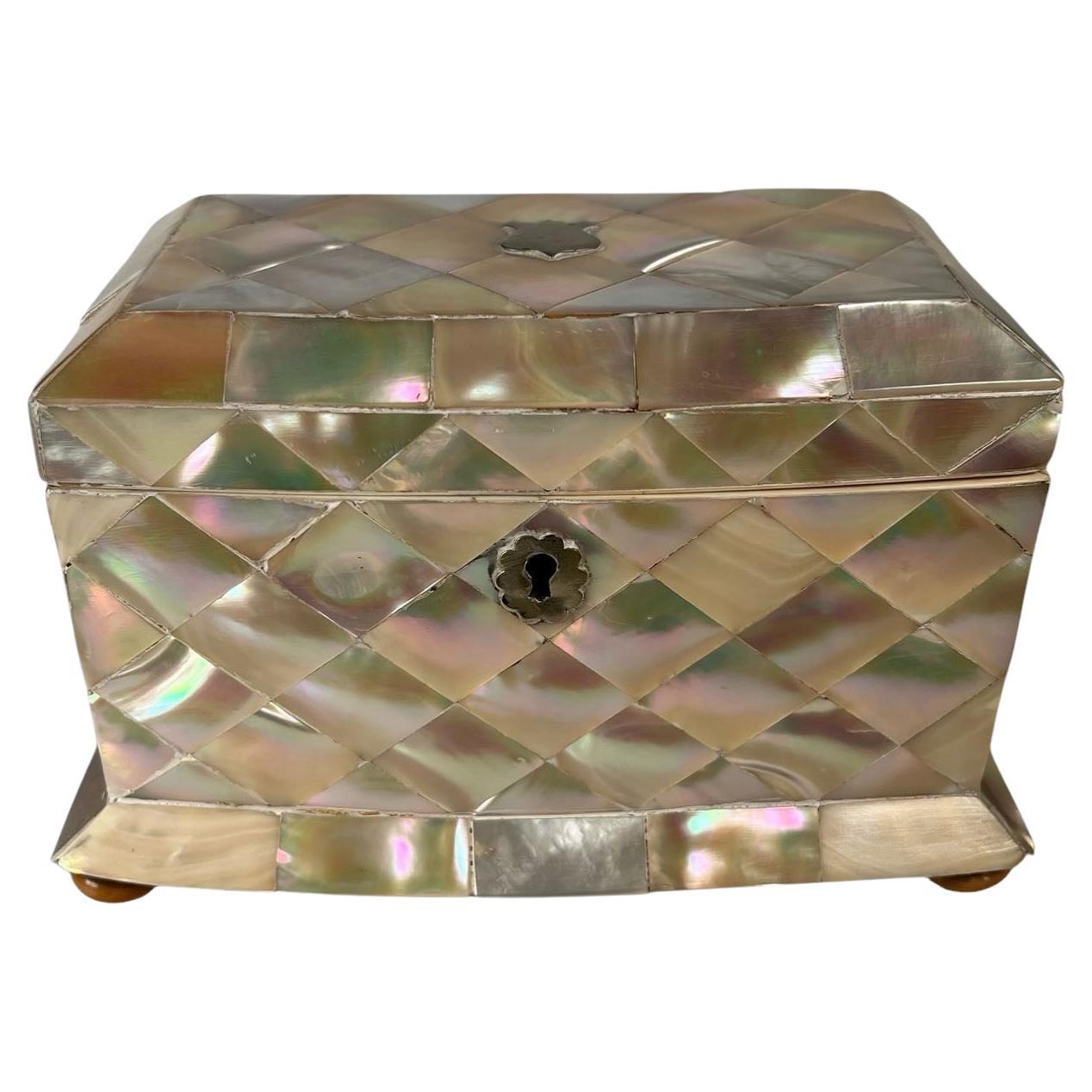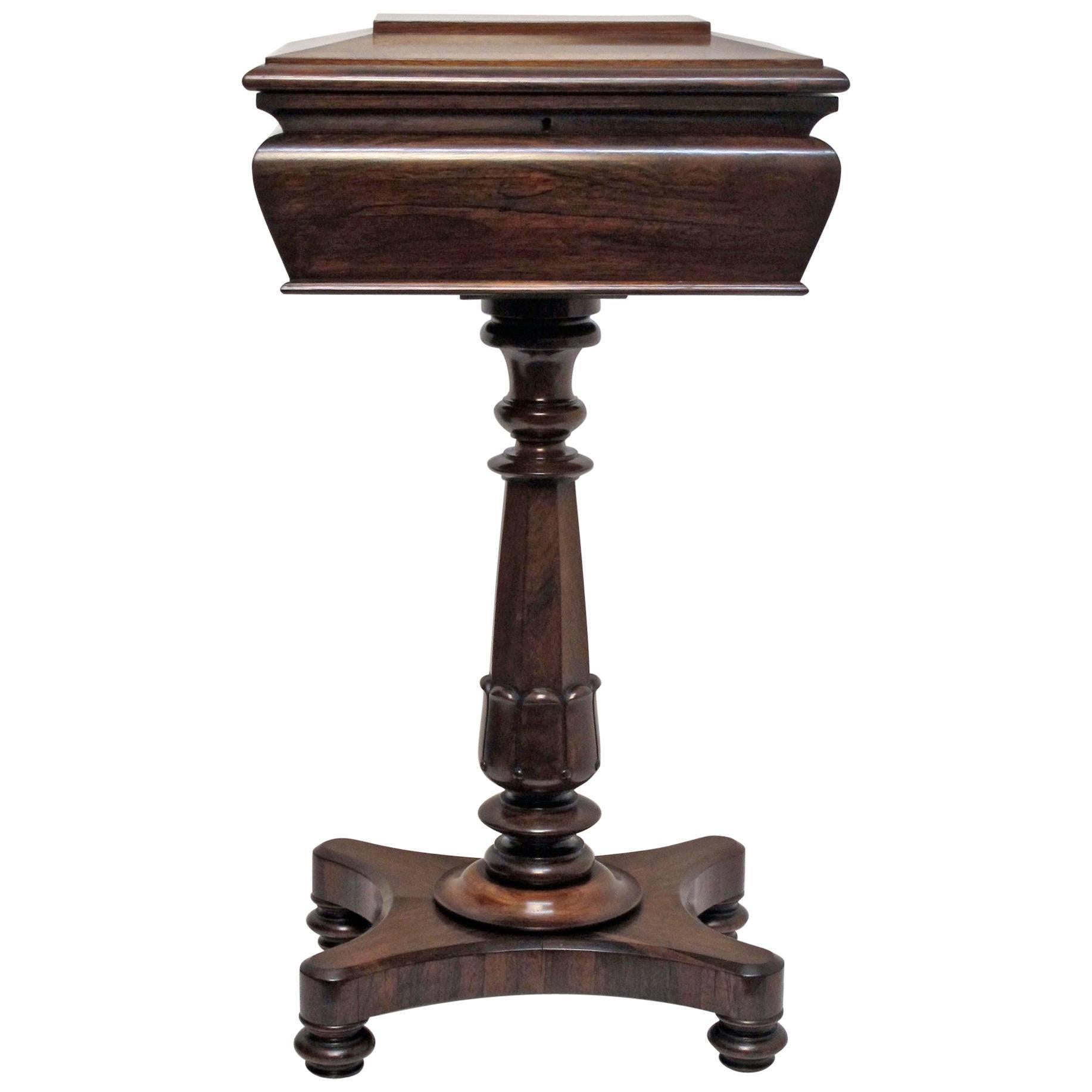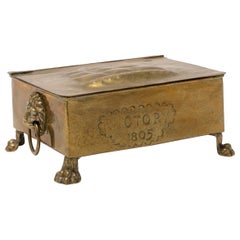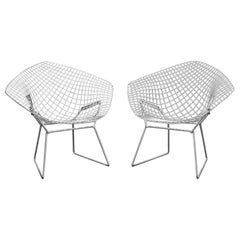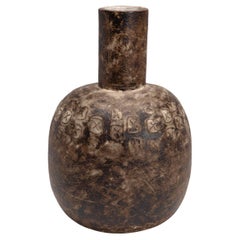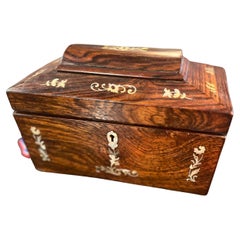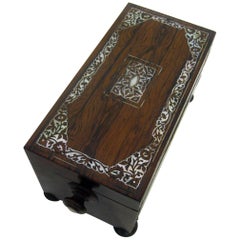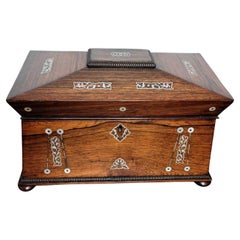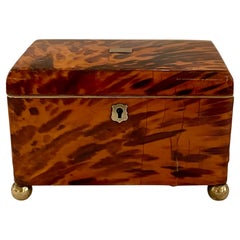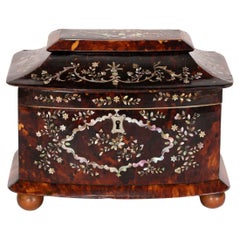
"Tea Caddy" English Tortoise Shell & Mother-of-Pearl Double Compartment 19th-c.
View Similar Items
Want more images or videos?
Request additional images or videos from the seller
1 of 18
"Tea Caddy" English Tortoise Shell & Mother-of-Pearl Double Compartment 19th-c.
Price:$2,175
About the Item
- Dimensions:Height: 5.75 in (14.61 cm)Width: 7.63 in (19.39 cm)Depth: 4.75 in (12.07 cm)
- Style:Regency (Of the Period)
- Materials and Techniques:
- Place of Origin:
- Period:
- Date of Manufacture:19th c.
- Condition:Repaired: lid repair and small area of shell. Replacements made: cloth. Refinished. Wear consistent with age and use. Very Good Condition. Very Pleasant Visually.
- Seller Location:Bloomfield Hills, MI
- Reference Number:1stDibs: LU7781236686082
About the Seller
5.0
Vetted Professional Seller
Every seller passes strict standards for authenticity and reliability
1stDibs seller since 2022
19 sales on 1stDibs
Typical response time: 3 hours
Authenticity Guarantee
In the unlikely event there’s an issue with an item’s authenticity, contact us within 1 year for a full refund. DetailsMoney-Back Guarantee
If your item is not as described, is damaged in transit, or does not arrive, contact us within 7 days for a full refund. Details24-Hour Cancellation
You have a 24-hour grace period in which to reconsider your purchase, with no questions asked.Vetted Professional Sellers
Our world-class sellers must adhere to strict standards for service and quality, maintaining the integrity of our listings.Price-Match Guarantee
If you find that a seller listed the same item for a lower price elsewhere, we’ll match it.Trusted Global Delivery
Our best-in-class carrier network provides specialized shipping options worldwide, including custom delivery.More From This Seller
View All"Victory 1805" Brass Box, Warm Color, Embossed Design, Lion's Head Handle
Located in Bloomfield Hills, MI
SALE ONE WEEK ONLY
"Victory 1805" brass box has exceptional details, the lion's head fixtures with brass rings, lions feet on which the box stands and the embossed etching of a sail...
Category
Antique Early 19th Century Unknown American Colonial Jewelry Boxes
Materials
Brass
Bertoia Diamond Chairs, White, Set of Two, Welded & Painted Steel
By Harry Bertoia
Located in Bloomfield Hills, MI
SALE ONE WEEK ONLY
Bertoia Diamond Chairs, White, Set of Two, Welded & Painted Steel. They are as elegant, strong and functional as when they were manufactured. The chairs will add a touch of class to any setting.
Harry Bertoia's career began in the 1930s as a student at Cranbrook Academy of Art where he re-established the metal-working studio and later became head of the department before the school closed during WWII due to wartime restrictions on materials in 1943. During the war, Bertoia moved to California and is credited with developing new techniques for molding plywood with Charles and Ray Eames also from Cranbrook.
Harry Bertoia is one of the many well-known artists and designers who attended The Cranbrook Academy of Art in Bloomfield Hills, Michigan, The school & buildings were designed by architect and faculty member, Eliel Saarinen who collaborated with Charles and Ray Eames on chair and furniture design. It is the country’s top ranked, graduate-only program in architecture, design and fine art. Each year, just 75 students are invited to study and live on the landmark Saarinen-designed campus which features: private studios, state-of-the art workshops, the renowned Cranbrook Art Museum and 300 acres of forests, lakes and streams, all a short drive from the city of Detroit. The focus at Cranbrook is on studio practice in one of ten disciplines including Architecture, 2D and 3D Design, Ceramics, Fiber, Metalsmithing, Painting, Photography, Print Media, and Sculpture. The program is anchored by celebrated Artists- and Designers-in-Residence, one for each discipline, all of whom live and practice on campus alongside the graduate students.
Numerous creative artists who are alumni of Cranbrook include: Florence Knoll, Jack Lenor Larsen, Donald Lipski, Duane Hanson, Nick Cave, Hani Rashid, George Nelson, Urban Jupena (Nationally recognized fiber artist), Artis Lane (the first African-American artist to have her sculpture, "Sojourner Truth," commissioned for the Emancipation Hall in the Capital Visitor Center in Washington DC), Cory Puhlman (televised Pastry Chef extraordinaire), Thom O’Connor (Lithographs), Paul Evans (Brutalist-inspired sculpted metal furnishings), Eugene Caples (small bronze images/abstract), Morris Brose (Bronze Sculptures), Herb Babcock (blown glass), Larry Butcher (mixed media), Lauren Anais Hussey (Abstract), Andrea Eis (film, photography), Lilian Swann Saarinen (Sculpture), Douglas Semivan...
Category
Mid-20th Century American Mid-Century Modern Chairs
Materials
Steel
"Wassily" Club Chairs B3 Designed by Marcel Breuer Set of Two Chrome & Leather
By Marcel Breuer
Located in Bloomfield Hills, MI
Wassily Club Chair by Marcel Breuer designed in 1925 - 26 for Knoll also known as the Model B3 chair. Breuer designed this chair while he was the head of the cabinet-making workshop at the Bauhaus, in Dessau, Germany. These chairs are in excellent condition and as strong and beautiful as when they were first created.
Inspired by the frame of a bicycle and influenced by the constructivist theories of the De Stjil movement, Marcel Breuer was still an apprentice at the Bauhaus when he reduced the classic club chair to its elemental lines and planes, forever changing the course of furniture design. His revolutionary Wassily chair marries durable leather with the industrial-age aesthetic of cantilevered tubular steel. Functional, simple and distinctly modern.
Protégé of Bauhaus founder Walter Gropius, Marcel Breuer embodied many of the School's distinctive concepts and was and one of the School's most famous students. He returned to teach carpentry from 1925-1928, during which he designed the tubular-steel furniture collection. His attention drifted towards architecture, and after practicing...
Category
Mid-20th Century German Mid-Century Modern Club Chairs
Materials
Chrome
Claude Conover Ceramic Stoneware Vessel Signed "Comitan" Inscribed Decorations
By Claude Conover
Located in Bloomfield Hills, MI
SALE ONE WEEK ONLY
"Comitan" is a stoneware vessel, 1980s, with a handsome elongated neck and full-body. The surface has a rich warm patina with cryptic scratches, stripes and hatchings marking the body. This gorgeous piece is a perfect example of Conover's best work.
Claude Conover was a ceramic sculpture artist described as falling within the styles of American, Modern and Contemporary Design. In 1983 he won The Cleveland Arts Prize competition in the visual arts for his bold and unique ceramic pieces that reflect strength of form and endurance unusual in the field. Using his own clay stoneware and mostly monochromatic colors, Conover decorated the surfaces with cryptic scratches, stripes and hatchings. Although decorative in intent, the indecipherable incised lines on his ceramics suggest some prehistoric unreadable script. The resultant works evoke a timeless monumentality reminiscent of ancient vessels whose utilitarian purpose is now lost to us. Within this limited repertoire, he produced beautiful, eternal works of art. Although Conover’s large impressive pots are his best work, he also made other forms, such as bowls, lamps, and ceramic animal sculpture.
Conover was born in Pittsburgh and educated at the Cleveland Institute of Art, where a number of prominent artists also attended: Brian Michael Bendis, Marc...
Category
Vintage 1980s American Vases
Materials
Ceramic, Stoneware
Royal Copenhagen Porcelain Figurine Knud Kyhn Monumental Lynx #2487
By Knud Kyhn
Located in Bloomfield Hills, MI
SALE ONE WEEK ONLY
The monumental "Lynx", the snarling cat, was modeled by Royal Copenhagen artist Knud Kyhn, and created ca. 1950. It’s a monumental piece and remarkably well-preserved with an expressive snarl. The figure is marked by Royal Copenhagen Denmark as shown and numbered 2487. It is in excellent condition with no damage.
Knud Kyhn (1880-1969) was a very productive artist who throughout his life created works of art that are still valued all over the world. In Denmark, he is especially known for his many animal figurines, which he created through his many years of service at Royal Copenhagen. He worked for the Royal Porcelain Factory from 1903 - 1910, 1924 - 1932 and 1936 - 1967, interrupted only by a period of work for Herman A. Kahler in Naestved in the early 1920s and at Bing & Grondahl 1908 - 1915 and 1933 - 1935.
He was a Danish painter, draftsman and ceramic sculptor. He was the nephew of the landscape painter, Vilhelm Kahn, and was educated at the Kunstakademiet and Kunstnernes Frie Studieskoler in 1904. He worked for the Royal Porcelain Factory, and a period with Herman Kahler in Naestved. He continued the tradition from the Fynbos and focused on animals and their movements as well as on the play of light in paintings...
Category
Vintage 1950s Danish Animal Sculptures
Materials
Porcelain
Bing & Grondahl Porcelain "The Tinderbox" Hans C Anderson 8051 Royal Copenhagen
By Jens Jakob Bregnoe
Located in Bloomfield Hills, MI
The Tinder Box is a small exquisite porcelain figurine that shines like a jewel. The figures are carefully created in great detail with much attention paid to the clothes and their decorations, the crutch, the cat, etc. This porcelain was based on the Hans Christian Anderson tale of “The Tinder Box”. A soldier is returning from the wars one day when he meets a witch. She tells him that she can give him riches, if he will do a favor for her. There is a hole at the top of a nearby tree. If the soldier climbs the tree, the witch tells him, and slides down the inside of the hollow trunk...
Category
Vintage 1970s Danish Figurative Sculptures
Materials
Porcelain
You May Also Like
19th Century English Regency Rosewood & Mother of Pearl Tea Caddy
Located in Scottsdale, AZ
19th Century English Regency Rosewood & Mother of Pearl Tea Caddy
Unique piece purchased in France. Age appropriate wear, see detailed photos or me...
Category
Antique 19th Century French Regency Tea Caddies
Materials
Rosewood
19th century English Rosewood Tea Caddy with Mother of Pearl Inlay
Located in Savannah, GA
Tea Caddy made of rosewood with extensive mother-of-pearl decoration to the top and front. Special features include bun feet and unusual handles on either side with mother-of-pearl b...
Category
Antique 1810s English Regency Tea Caddies
Materials
Mother-of-Pearl, Rosewood
$995 Sale Price
37% Off
Early 19th Century English Regency Rosewood Mother-of-pearl Tea Caddy
Located in Forney, TX
An elegant fine quality English Regency period tea caddy. Circa 1815
Born in the early 19th century, exquisitely hand-crafted from the finest exotic rosewood, rectangular sarcopha...
Category
Antique Early 19th Century Regency Tea Caddies
Materials
Mother-of-Pearl, Rosewood
Antique English Tortoise Shell Tea Caddy
Located in New Orleans, LA
A beautiful tea caddy. The tortorise shell color is perfection.
Category
Antique Late 19th Century English Tea Caddies
Materials
Tortoise Shell
Fabulous Antique English Penwork Double Compartment Tea Caddy c.1820
Located in Bath, GB
A simply magnificent and grand example of a Regency Penwork Tea Caddy dating 1820.
The caddy stands on it's original large gilded bronze Lion's paw feet and the sides retaining the ...
Category
Antique 1820s British Regency Tea Caddies
Materials
Wood
$3,862 Sale Price
20% Off
Free Shipping
19th Century English Victorian Cormandel Mother of Pearl Tea Caddy, circa 1850
Located in Banner Elk, NC
English Victorian cormandel tea caddy decorated with mother of pearl and brass studs, circa 1850s. Cormandel was considered one of the most luxurious woods and only used on the fines...
Category
Antique Mid-19th Century English Victorian Tea Caddies
Materials
Brass
Recently Viewed
View AllMore Ways To Browse
Pearl Of Mother Box China
Chinese Inlaid Box
Sarcophagus Tea Caddy
Mother Of Pearl With Tortoise Shell
Tea Caddy With Mother Of Pearl
Chinese Silver Tea Caddy
English Mother Of Pearl Inlaid Tea Caddy
Islam Jewelry
Regency Pearls
Wood Casket
Iron Lock Box
Antique Burr Box
Enamel Cigarette Box
French Gilt Glass Box
Japanese Enamel Box
Porcelain Trinket Box
Rosewood Box Inlay
Antique Cloisonne Boxes
